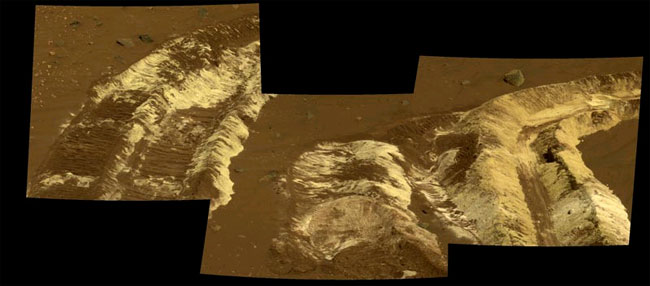
Scientists are puzzling over new Mars rover data that reveal soil packed with sulfur and traces of water. The finding could be evidence of an evaporated spring or volcanic deposits from ancient gas vents.
While digging around in Mars' Columbia Hills last year, NASA's Spirit rover unearthed bright white and yellow material [image] hidden beneath a layer of normal reddish soil. The material is sulfur-rich and consists of sulfate salts associated with iron and possibly even calcium.
"These salts could have been concentrated by hydrothermal liquid or vapor moving through the local rocks," said Albert Yen, a geochemist at NASA's Jet Propulsion Laboratory and a rover science team member.
Researchers are currently on the lookout for more patches of bright soil. Where they find it could provide clues about its origins. "If we find them along fractures, that would suggest they were deposited at ancient vents," said Ray Arvidson of Washington University and deputy principal investigator of the rover mission.
"If they are saddles between hills, that would suggest the deposits formed where groundwater came to the surface," Arvidson said.
Meanwhile, halfway around the Martian world, Spirit's twin is exploring Victoria Crater, a bowl nearly half a mile (800 meters) across. Called Opportunity, the rover has beamed back images of layers of rock that were once buried before a meteorite carved out the depression.
"The images are breathtaking," said Steve Squyres of Cornell University, principal investigator for the rovers. "Every promontory we've seen has the kinds of layering expected for ancient wind-blown sand deposits."
Get the Space.com Newsletter
Breaking space news, the latest updates on rocket launches, skywatching events and more!
Those layers are also abundant in sulfate-rich sandstone and likewise hint at a wet period in the Red Planet's distant past.
- Image Gallery: Visualizations of Mars
- Underground Plumbing System Discovered on Mars
- Study Reveals Young Mars Was a Wet World
- Mars Opportunity's Photo Journal
- Zoom in: Water on Mars?
Join our Space Forums to keep talking space on the latest missions, night sky and more! And if you have a news tip, correction or comment, let us know at: community@space.com.
Ker Than is a science writer and children's book author who joined Space.com as a Staff Writer from 2005 to 2007. Ker covered astronomy and human spaceflight while at Space.com, including space shuttle launches, and has authored three science books for kids about earthquakes, stars and black holes. Ker's work has also appeared in National Geographic, Nature News, New Scientist and Sky & Telescope, among others. He earned a bachelor's degree in biology from UC Irvine and a master's degree in science journalism from New York University. Ker is currently the Director of Science Communications at Stanford University.
